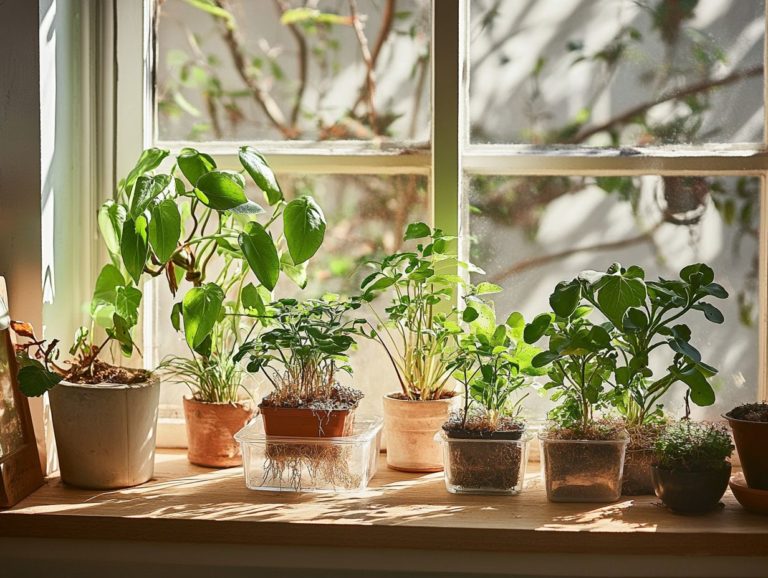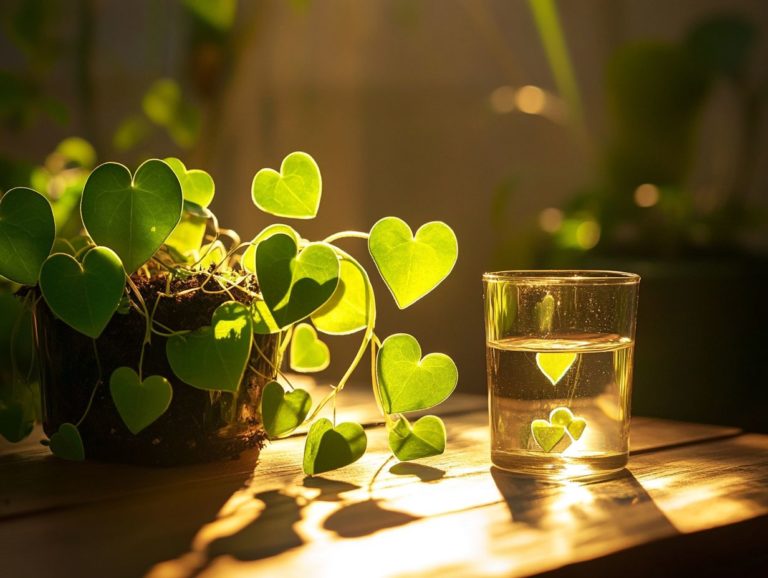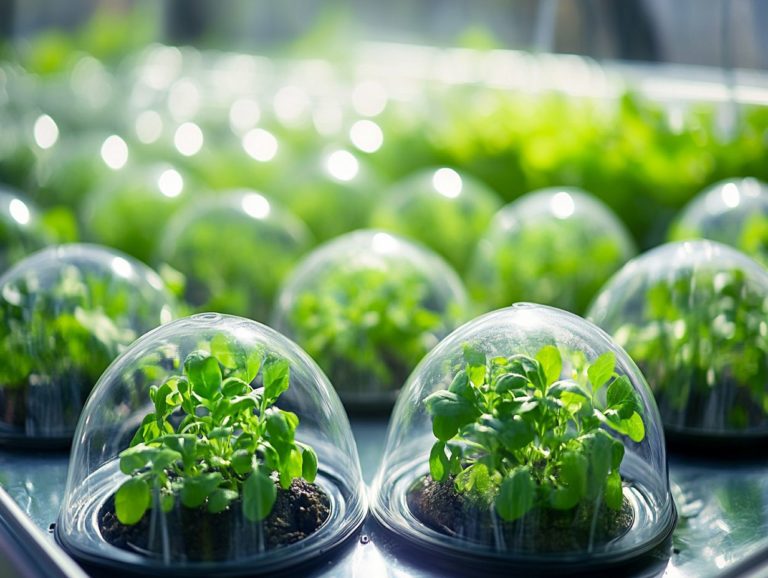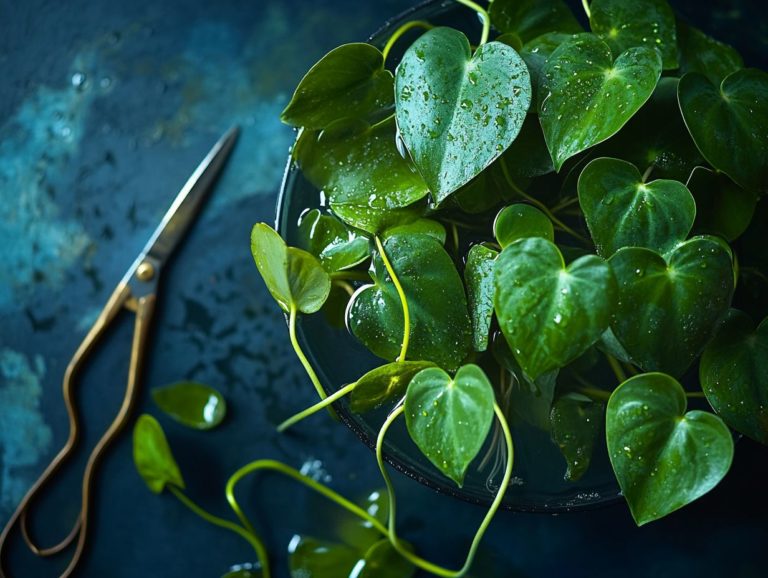The Art of Air Layering Indoor Plants
Air layering is a simple way to grow new plants from your existing ones. It s perfect for houseplant lovers who want to expand their collection without cutting their plants.
This method proves particularly effective for indoor gardening enthusiasts eager to create stunning gardening projects at home. You ll delve into the definition and purpose of air layering and uncover its myriad advantages.
We’ll shine a light on common pitfalls to sidestep and offer recommendations for the best indoor plants, such as the weeping fig and rubber tree, that thrive with air layering.
Get ready to transform your indoor garden! Prepare to unveil the secrets to nurturing your indoor garden with techniques that enhance plant selection.
Contents
- Key Takeaways:
- What is Air Layering?
- Why Use Air Layering for Indoor Plants?
- Step-by-Step Guide to Air Layering
- Common Mistakes and How to Avoid Them
- Best Plants for Air Layering
- Frequently Asked Questions
- What is air layering and why is it important for indoor plants?
- What materials are needed for air layering indoor plants?
- What types of indoor plants are suitable for air layering?
- What is the best time of year to air layer indoor plants?
- How long does it take for roots to form when air layering indoor plants?
- Do I need to remove the air layer from the parent plant once roots have formed?
Key Takeaways:
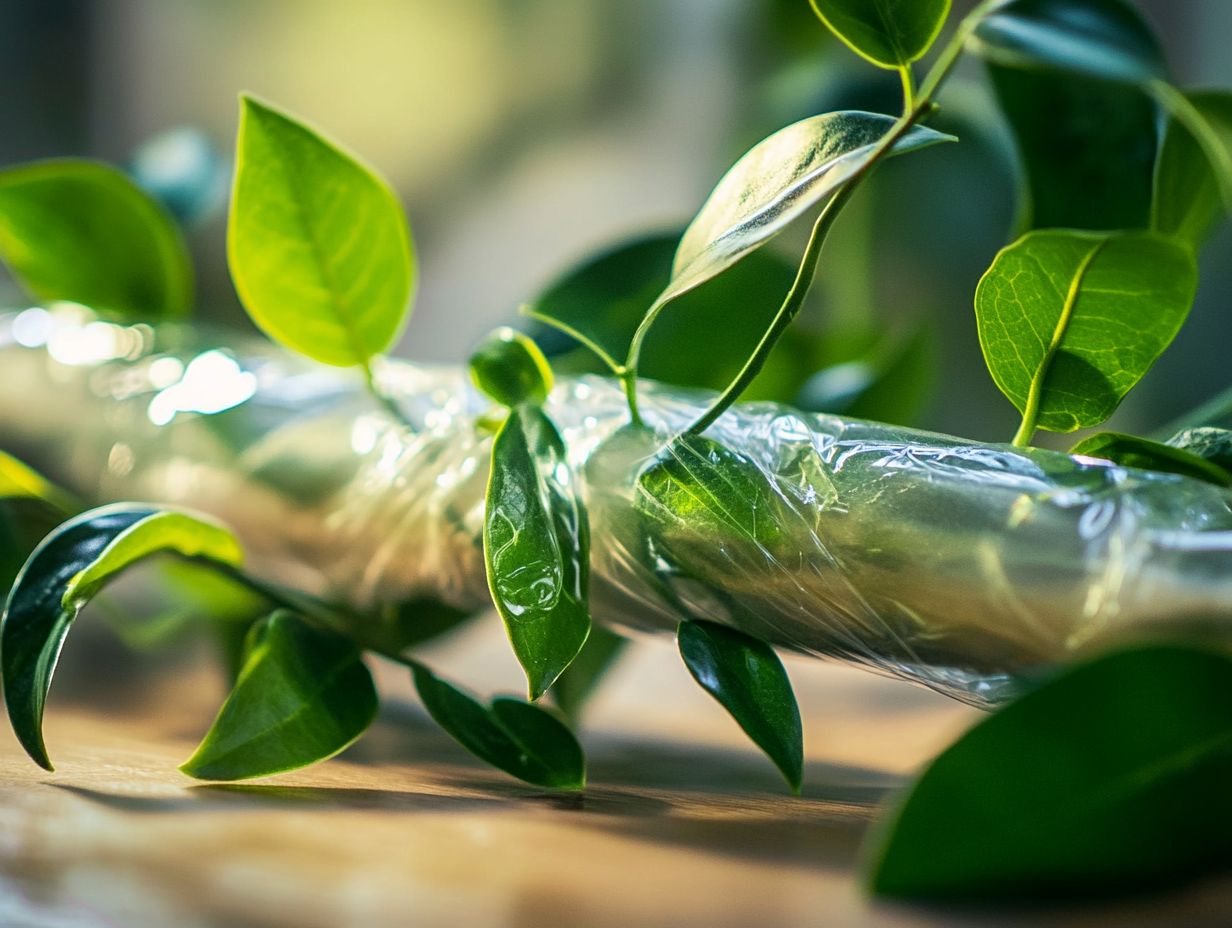
- Air layering is a propagation technique that involves creating new roots on a plant’s stem while it is still attached to the parent plant.
- It is a great method for propagating indoor plants because it allows for quicker and more reliable results, helping tropical plants adapt to their new environment faster.
- Proper materials and techniques, such as using long-fibered sphagnum moss and rooting hormone, are crucial for successful air layering. Avoid common mistakes like choosing the wrong plants or using incorrect tools to achieve the best results.
What is Air Layering?
Air layering is an elegant plant propagation technique that gives you the power to cultivate new plants while keeping the parent plant unharmed. This method shines particularly when working with woody plants like the rubber tree, philodendron, and Ficus benjamina favorites among houseplant aficionados.
By employing materials such as moistened sphagnum moss and rooting hormone, especially those containing plant hormones that help roots grow, you can effectively stimulate root development in a controlled setting. This makes air layering a superb strategy for both aspiring horticulturists and seasoned experts to propagate plants efficiently.
Definition and Purpose
Air layering is a fascinating propagation method that encourages new root growth on a branch while it remains attached to the parent plant. This technique serves a dual purpose: it helps expand your gardening collection while also maintaining the overall health of your plants.
By employing air layering, you can easily multiply your favorite varieties of houseplants, whether you re a hobbyist or a seasoned professional. This method allows you to preserve the genetic traits of the parent plant, ensuring that you maintain the quality you desire.
Compared to traditional methods like seed germination or cuttings, air layering stands out with its higher success rate in propagating plants and quicker establishment of root systems. Certain species, such as avocados and figs, particularly thrive with this method, showcasing their robust ability for new root development.
Their growth patterns align perfectly with the air layering process, resulting in a robust new plant ready for your ongoing cultivation efforts.
Why Use Air Layering for Indoor Plants?
Using air layering for your indoor plants offers several compelling advantages, including the ability to propagate houseplants without cutting the parent plant. This technique enhances the overall health of your plants by allowing new roots to develop while the parent plant continues to flourish.
It also gives you the power to expand your houseplant collection without sacrificing your existing plants. Air layering can also be tailored for specific indoor plants, ensuring optimal growth and enhancing your ecological plant selection.
Step-by-Step Guide to Air Layering
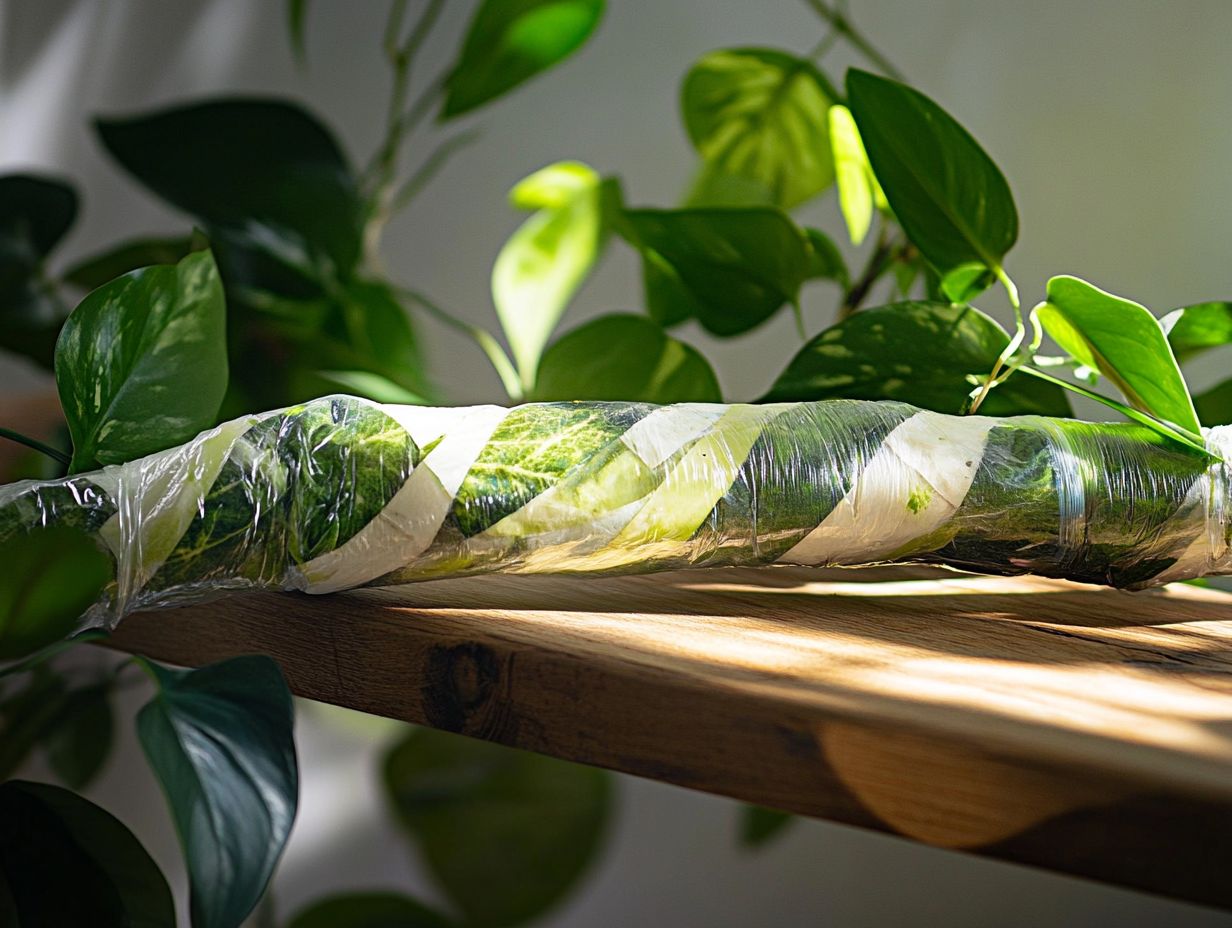
To master the art of air layering, you’ll need a detailed, step-by-step guide that outlines the essential materials and tools. Gather these must-have items to kickstart your air layering adventure!
These include cutting tools, rooting hormone, and long-fibered sphagnum moss for effective propagation. These items are crucial for ensuring proper maintenance practices.
By following this guide, you can cultivate new roots while ensuring the health of both the parent plant and the new one. This paves the way for a successful propagation journey with minimal errors.
Materials and Tools Needed
The essential materials and tools for successful air layering include:
- Rooting hormone
- Long-fibered sphagnum moss
- A sharp knife
- Plastic wrap to retain moisture
Each of these components is vital for ensuring that new roots develop effectively, especially for woody plants like the rubber tree and philodendron.
Wearing garden gloves protects your hands while you handle sharp tools, ensuring your safety throughout the process of caring for your plants.
Rooting hormone is particularly crucial as it stimulates root development. Opt for a high-quality product containing natural chemicals that help roots grow to achieve optimal results in your air layering projects.
When properly moistened, sphagnum moss creates a humid environment around the cutting, essential for robust root formation and optimal plant health.
For the plastic wrap, choose a durable, breathable option to prevent mold growth while efficiently retaining moisture. Sourcing these materials from reputable nurseries or garden centers will significantly increase your chances of success in air layering, especially with tropical plants.
Techniques and Tips
When you choose air layering as a propagation technique, several strategies can significantly boost your chances of success and foster optimal root growth for your houseplants.
It’s crucial to grasp the right atmospheric conditions humidity and temperature as they play vital roles in creating an ideal environment for root development and plant health.
Keeping moisture levels consistent around the layering site is essential for maintaining optimal growth. Consider using sphagnum moss or a similar medium; this will help retain moisture while still allowing for necessary airflow, vital for plant care.
Being vigilant about the plant’s health is equally important to ensure successful propagation. Watch for any signs of stress or disease, as these can provide early warnings that adjustments are needed. Ensure that the mother plant is well-nourished; a healthy plant will better support new growth and thrive in your indoor garden.
Remember, patience is key! Allow ample time for new roots to establish. Timing the removal of the new cuttings just right ensures that they re ready for transplanting, making the entire process not only more efficient but also incredibly rewarding.
Common Mistakes and How to Avoid Them
When you embark on air layering to propagate your plants, it s essential to recognize the common missteps that can impede your success. Understanding how to avoid these pitfalls is vital for effective plant care and thriving houseplants.
Key mistakes include improper cuts and neglecting to use rooting hormone:
- Making improper cuts
- Neglecting to apply rooting hormone
- Failing to ensure sufficient moisture levels in the sphagnum moss
Each of these errors can jeopardize the root development process, making troubleshooting a crucial skill for any gardener eager to master this propagation technique and improve their horticulture expertise.
Ready to try air layering? Let’s get started on growing your indoor garden today!
Troubleshooting and Problem Solving

Troubleshooting during the air layering process is crucial. Common problems include inadequate root development and mold growth on the sphagnum moss used for propagation.
Identifying these issues early allows you to implement targeted solutions. This significantly enhances the success rate of your techniques and promotes healthy plants.
Common challenges in air layering often arise from factors like insufficient moisture levels or improper wrapping techniques. These can impede the establishment of healthy roots and hinder plant care.
To tackle these setbacks, regularly monitor the moisture content of the medium. Ensure it stays consistently damp but not overly saturated for the best results.
Using transparent plastic to cover the moss helps maintain adequate humidity. It also allows for easy visibility, so you can keep an eye on progress.
Adopting maintenance practices like avoiding overcrowding and providing the best light for your plants helps them thrive. These efforts ultimately lead to a thriving new plant.
Best Plants for Air Layering
When considering air layering as a propagation method, certain indoor plants respond remarkably well. The rubber tree and philodendron are prime candidates for expanding your houseplant collection.
Consider species like the weeping fig, rubber tree, and philodendron. They are excellent for air layering, showcasing robust root development that enhances your gardening endeavors.
Indoor Plants That Respond Well to Air Layering
Several indoor plants exhibit an impressive capacity for air layering, making them prime candidates for propagation. Noteworthy species like Ficus benjamina, known as the weeping fig, and the rubber tree stand out.
These plants flourish under the right conditions and thrive through the air layering process. This promotes robust root growth without traditional soil propagation.
The weeping fig, for example, favors bright, indirect light and humidity. Meanwhile, the rubber tree enjoys slightly darker spaces, as long as it receives some sunlight daily.
Select a healthy stem and keep the humidity just right. This exciting method of propagation allows you to expand your indoor jungle!
Try this propagation method today and transform your living space into a lush oasis!
Summary and Final Thoughts
Air layering is a great way to propagate houseplants. It benefits both indoor gardening enthusiasts and professional horticulturists.
This technique allows new roots to develop while still attached to the parent plant. The young plant benefits from the established root system until it s ready to thrive independently.
For those who enjoy nurturing plants from cuttings, air layering provides a more reliable outcome. This significantly increases your chances of successful propagation.
By producing clones of your favorite plants, you can maintain specific traits. This ensures that beloved characteristics are preserved in each new generation.
Reflecting on the benefits of air layering, it s clear that this method enhances the diversity of your indoor garden. It also fosters a deeper connection between you and your plants.
Ready to try this technique? Start with easily propagable species and explore other innovative plant care practices that will enrich your gardening experience.
Frequently Asked Questions

What is air layering and why is it important for indoor plants?
Air layering is a propagation method. It creates roots on the stem of a plant while it is still attached to the parent plant.
This allows for a new, self-sufficient plant to grow without separating it from the original plant. It is important for indoor plants because it can produce a larger and more mature plant in a shorter time than other methods.
What materials are needed for air layering indoor plants?
To successfully air layer an indoor plant, you will need a sharp knife, rooting hormone, plastic wrap, sphagnum moss, and string or twist ties.
Using rooting hormone helps stimulate root growth.
What types of indoor plants are suitable for air layering?
Air layering can be done on various indoor plants. It is most successful on plants with long stems and flexible branches, such as rubber trees, dieffenbachias, and philodendrons.
It can also be done on plants with thicker stems, but it may take longer for roots to form.
What is the best time of year to air layer indoor plants?
The best time to air layer indoor plants is during the active growing season. This is typically in the spring and early summer.
During this time, the plant is actively producing new growth and has the best chances of producing roots.
How long does it take for roots to form when air layering indoor plants?
The time it takes for roots to form when air layering indoor plants can vary. Typically, it takes 4-8 weeks for roots to develop.
This can depend on the type of plant, environmental conditions, and proper care during the process.
Do I need to remove the air layer from the parent plant once roots have formed?
Yes, once roots have formed on the air layer, carefully remove it from the parent plant. Plant it in its own container with potting soil.
This allows the new plant to establish itself and continue to grow on its own.

